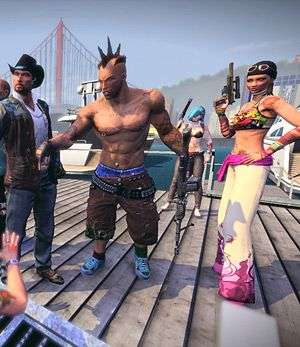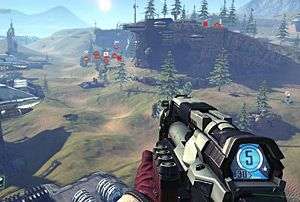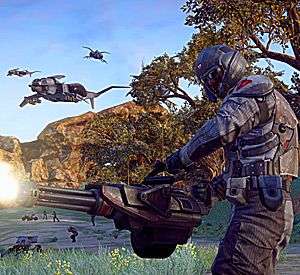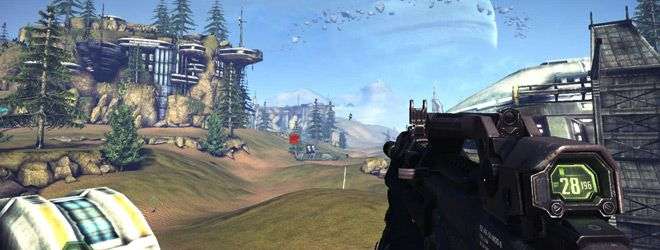The Light and Dark Side of Free to Play Gaming
by Chris P
 I’ve played a small number of free-to-play games in my time and so far, APB: Reloaded is the one I spent the most time on, though I now no longer play it. Hopping on with friends and teaming up to have some fun for a few hours every night was a great time, but I got a bit sick of it for a number of reasons. One of those being that the shooting felt like shit, but the main reason was the unfair way their micro-transactions system had been set up.
I’ve played a small number of free-to-play games in my time and so far, APB: Reloaded is the one I spent the most time on, though I now no longer play it. Hopping on with friends and teaming up to have some fun for a few hours every night was a great time, but I got a bit sick of it for a number of reasons. One of those being that the shooting felt like shit, but the main reason was the unfair way their micro-transactions system had been set up.
In this new lease of life for APB, GamersFirst have decided to make some weapons “premium” only, meaning that you pay real cash to use them. That would be completely fine if they were just cosmetic, or you could eventually get them for yourself through playtime, but you can’t, they’re cash only. Most of these are rentals as well, while some you can buy permanently, but they also happen to be, hands down, the best weapons in the game. That means most of the fights I came across had a couple of people using these, and I’d be at a severe disadvantage, no matter what weapons we had unlocked and modified (using the in-game modification systems).
Even with superior tactics, it can be hard to pull a win out of those situations, especially if you eventually have to face the enemy calling in back-up, that more often than not, would include more of these players with the overpowered pay-to-win arsenal. Or those dicks with the rocket launchers.
Not long afterwards, I became extremely frustrated and annoyed at this fact, and after playing for nearly 200 hours I quit for good. I just wasn’t having fun any more, and it was just becoming more stress inducing, which I really don’t need outside of University coursework. That was when I finally acquired a code to play Tribes: Ascend – another free-to-play shooter. I had played a small amount of Tribes 2 back in the day and really enjoyed its unique source of fast, frantic and explosive action. I even had nostalgic moments seeing the jetpacks in Halo: Reach when they were announced, but nothing since those initial Tribes titles had ever been similar; the speed was never there, and it had been vacant from shooters for a long while.
After only a couple of games of Tribes, it all came back to me; I got the hang of skiing, I did my fair share of killing and I was having a blast while doing it. None of the previous frustration from APB had resurfaced, and it was glorious. However, the more I played, the time I had to discover the micro-transactions that Hi-Rez had deployed. I was relieved to find out that everything you can purchase with real money (or “Tribes Gold” in this case) you can also earn via XP you gain from matches, the only exceptions to this being XP boosters. I was overjoyed; finally I can play a game that I’m really into and I don’t even have to worry about someone who only has to spend some cash to have a leg up. I can hold my own in a match purely with skill, and it feels great.
 I’ve spent a decent amount of time with Tribes: Ascend now, trying out multiple different classes and purchasing new upgrades and weapons via in-game XP and Tribes Gold alike. I feel no remorse for my purchases, using it for the more expensive items and experience boosts to help me try out new things, rather than get an upgrade I feel is needed to play better. I know for a fact that they don’t matter, as even with the little upgrades I may have for the classes I play, I still hold my own, coming in the top of my team and supporting everyone where I can. It feels fair, it feels skilful and I feel like I’m giving money to a developer that has earned my money, rather than demanded it.
I’ve spent a decent amount of time with Tribes: Ascend now, trying out multiple different classes and purchasing new upgrades and weapons via in-game XP and Tribes Gold alike. I feel no remorse for my purchases, using it for the more expensive items and experience boosts to help me try out new things, rather than get an upgrade I feel is needed to play better. I know for a fact that they don’t matter, as even with the little upgrades I may have for the classes I play, I still hold my own, coming in the top of my team and supporting everyone where I can. It feels fair, it feels skilful and I feel like I’m giving money to a developer that has earned my money, rather than demanded it.
It’s great to see that a developer really understands what players want from the free-to-play model; what will keep players playing in the long run and what can still be profitable for the developer don’t have to be so far away from each other that it sacrifices good gameplay standards. Hi-Rez definitely see that, and even have an open communication with their player base, resulting in them adding in a Deal of the Day system, giving vast discounts to a specific item every day and adding in a referral system that rewards Tribes Gold and XP for people who introduce friends to their title. They even have a “Celebrity” status for vast numbers of subscribers, which TotalBiscuit and sXePhil – two big YouTubers in different fields – have already achieved. This unlocks everything for them, and once they have enough referrals, gives them the opportunity to design a map for the game. It’s a great way to reward dedication, and I’m happy it’s there, even though none of my friends use my referral link, the bastards.
 Though Tribes: Ascend is attempting to fix its slightly overpriced purchases (both via real money and experience) another example of these giant funds comes from Super Monday Night Combat, the free-to-play DOTA-style sequel to an old XBLA game. While the game itself is definitely different, and leans towards the MOBA style more than the third person shooter/tower defence hybrid of the original, it does have a free-to-play system that doesn’t feel like a rip off. Though I’ve not put down real money for anything, the amount of currency – both in-game and otherwise – seems rather large for what you’re actually paying for. Pros and their costumes just seem too expensive to pay for, and each match gives out a small amount of currency. This is especially daunting as, through my experience, getting into matches can take a while of sitting and staring at the queue-screen.
Though Tribes: Ascend is attempting to fix its slightly overpriced purchases (both via real money and experience) another example of these giant funds comes from Super Monday Night Combat, the free-to-play DOTA-style sequel to an old XBLA game. While the game itself is definitely different, and leans towards the MOBA style more than the third person shooter/tower defence hybrid of the original, it does have a free-to-play system that doesn’t feel like a rip off. Though I’ve not put down real money for anything, the amount of currency – both in-game and otherwise – seems rather large for what you’re actually paying for. Pros and their costumes just seem too expensive to pay for, and each match gives out a small amount of currency. This is especially daunting as, through my experience, getting into matches can take a while of sitting and staring at the queue-screen.
It’s definitely something that multiple developers have tried to address, and finding that sweet spot may take some time, as the balance between satisfying the player base and still making a profit can be hard to nail. Multiple factors make this even harder, with some entitled players voicing unwarranted concerns so they can get the equivalent of a free ride, drowning out any legitimate concerns of honest players. A lot of praise is directed towards Riot, the developers of League of Legends and their model; customization and boosts are the only items that are real-money only, and everything else is obtainable solely through putting in the hours. I’ve had some experience with this personally, having played a small amount of League of Legends, and it does work very well – spending some in-game cash on a skin didn’t feel like I was being cheated, and I felt like I gave back for the enjoyment I had with the time I had playing. It was even noted by Sony Online Entertainment that they admire this system in particular, and hoped to apply a similar one to Planetside 2.
 Though it is still a shooter, Planetside 2 is a MMOFPS, and it’s one of the many MMOs in recent times to adopt a free-to-play model. Though some have been converted to the system, launching with it is also a move that shows even Sony know the world is changing and free-to-play isn’t a dirty phrase anymore. I’m certainly excited to play it, and although I’m not keen on an MMO itself being free-to-play, it makes me excited specifically about Planetside because it means I won’t have to pay anything to actually try it out. The things they’re looking at to help players while trying to make money also gives me hope that the transaction model won’t be as bad as I feared it could be, because besides all the praise I can give releases like LoL and Tribes for their micro-transactions, I don’t want every title out there to be free-to-play, especially a subscription-based MMO that I play very often, Star Wars: The Old Republic.
Though it is still a shooter, Planetside 2 is a MMOFPS, and it’s one of the many MMOs in recent times to adopt a free-to-play model. Though some have been converted to the system, launching with it is also a move that shows even Sony know the world is changing and free-to-play isn’t a dirty phrase anymore. I’m certainly excited to play it, and although I’m not keen on an MMO itself being free-to-play, it makes me excited specifically about Planetside because it means I won’t have to pay anything to actually try it out. The things they’re looking at to help players while trying to make money also gives me hope that the transaction model won’t be as bad as I feared it could be, because besides all the praise I can give releases like LoL and Tribes for their micro-transactions, I don’t want every title out there to be free-to-play, especially a subscription-based MMO that I play very often, Star Wars: The Old Republic.
The issue with the free-to-play model in The Old Republic is simple; with the way it’s worked out I’d be better off continuing to pay for the subscription model anyway. I have a lot of alt-characters, I had a great number of quick bars filled with abilities and I enjoyed all of the PvP and Space missions. All of these are limited in their free option, meaning that I’d either be locked out of them or will be limited to which ones I can actually do. There’s also their premium option, which is essentially “unlocked” when you pay for something using the new currency or were previously subscribed, meaning that if I did go back without paying, there’d be a little more for me to play around with, rather than just going in completely from scratch. It’s definitely a model that was hashed together after they realised they cannot sustain themselves with the old MMO model, and it really is a shame. There will be a point where I can feel happy about going back, but it’s going to be at a time where I can happily afford to play, and I’m sad that it’s been happening this way.
 Another reason I feared that change was the fact that a lot of MMOs that made this change did so because they were on the way out; they were dying and needed a boost in the playerbase to keep afloat. It terrified me because I absolutely love The Old Republic, I invested so much lot of time into it because it drew me in far more than World of Warcraft ever did, and its refined, fluid and kinetic gameplay just kept me there because every time I jump in and get comfy it brings a smile on my face. It’s just so much fun and that’s what I was scared of losing.
Another reason I feared that change was the fact that a lot of MMOs that made this change did so because they were on the way out; they were dying and needed a boost in the playerbase to keep afloat. It terrified me because I absolutely love The Old Republic, I invested so much lot of time into it because it drew me in far more than World of Warcraft ever did, and its refined, fluid and kinetic gameplay just kept me there because every time I jump in and get comfy it brings a smile on my face. It’s just so much fun and that’s what I was scared of losing.
So there you have it, the good and bad, light and dark of my experience in the free-to-play ocean that’s out there right now in the gaming industry. Some of it is definitely here to stay, and everyone’s trying to improve it for the better. It’s only a matter of time before the pay-to-win model disappears entirely, and we’re left with value for money and time spent in these games. I’m keeping a watchful eye on it all, and I see the benefits and detrements to it all. Rest assured, the more varied videogames are, the better it is for everyone.
Last five articles by Chris P




















I’m not so sure that the pay to win model will disappear entirely. It’s just too simple to add to a game that changes to F2P late in development and guarantees a revenue stream in the short term. Over time people will leave these games due to those people who paid for their godlike weapons overpowering them, but by then they’ll already have made their money.
However, like you I see an optimistic future for F2P as a growing model. Quality games designed around that concept are starting to show up now. Things like experience packs or boosters on sale to let players get further faster are a nice addition for those who don’t care about the slower road but now essential. Costume and other cosmetic packs are always a good money maker and can add to the feel of a game you enjoy.
I’m not entirely sure about the rent-a-feature thing that is coming up recently. I get that having a F2P model running alongside a premium model is difficult, and there needs to be some reasons to pay money. Locking features away behind a paywall and giving limited access to them after buying a key or even regular paid item seems like it could go both ways to me. Still, if balanced right with enough of the feature outside the paywall to give a taste, it could well be a nice way to further monetise a free game so long as it doesn’t turn into a disguised subscription model.
All in all, F2P is a newish concept still and there are a lot of kinks to be worked out. Yes, people will take advantage and try to attract gamers with a free game while requiring payments above the worth of the game to get any fun from it. Yes, people will release games that need their balancing addressed before the free versus paid stuff is fairly distributed (which is a tough topic to broach without sounding like you want it all for free). Yes, games that are in trouble will adopt a F2P model in desperation, and make mistakes about what form of that model will best suit them. But, in the end, I think we’ll look back at this and laugh about the drama surrounding the concept, just like we do with being able to save games and health bars replacing lives.